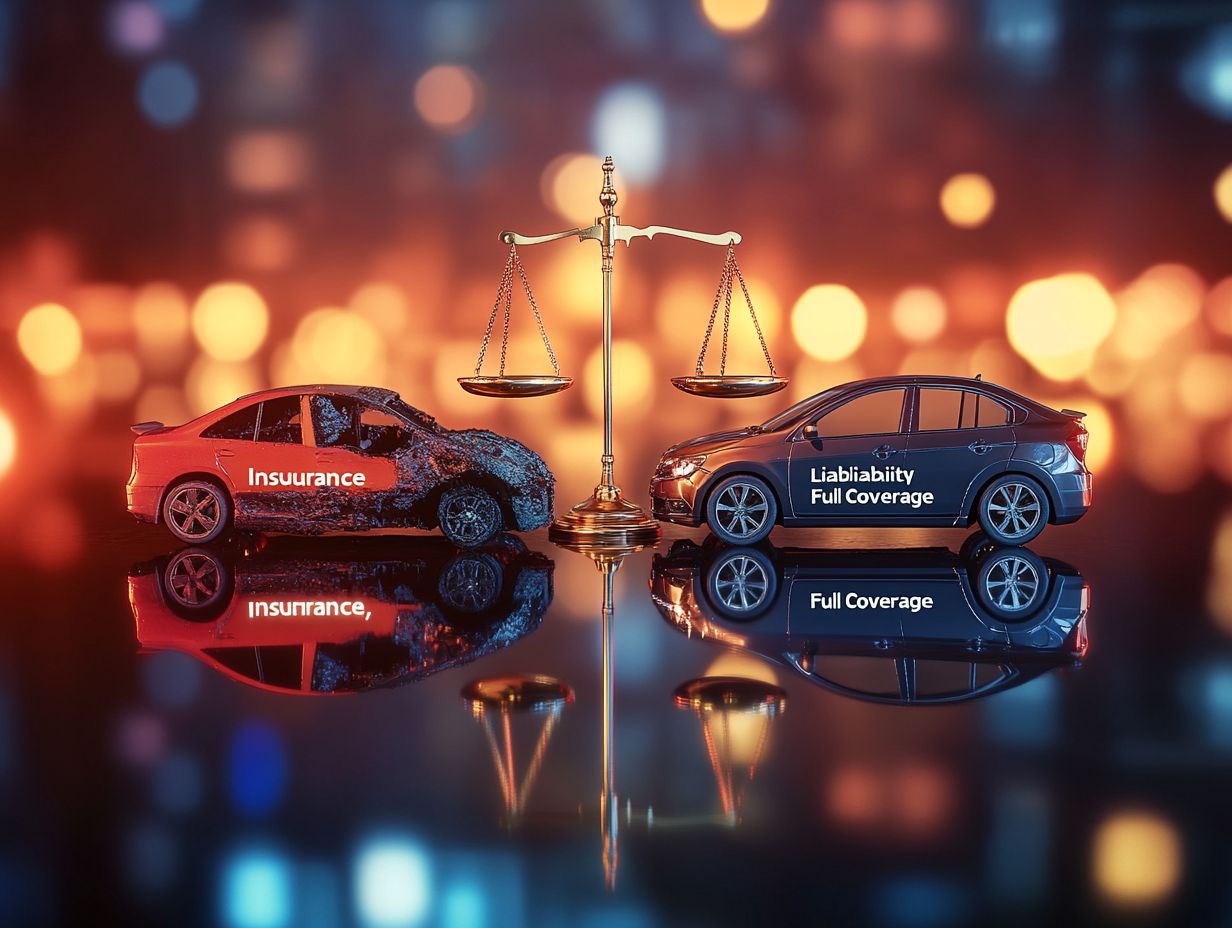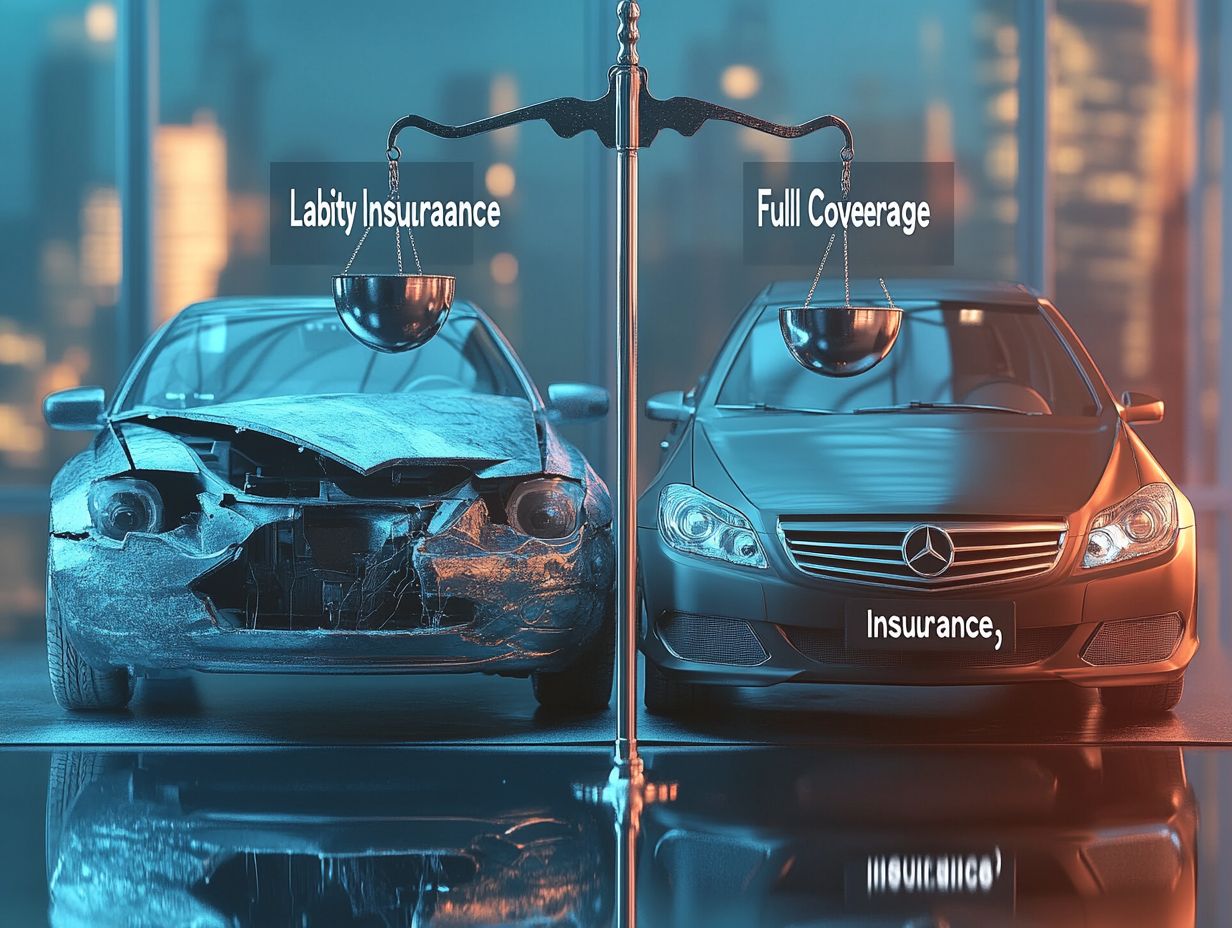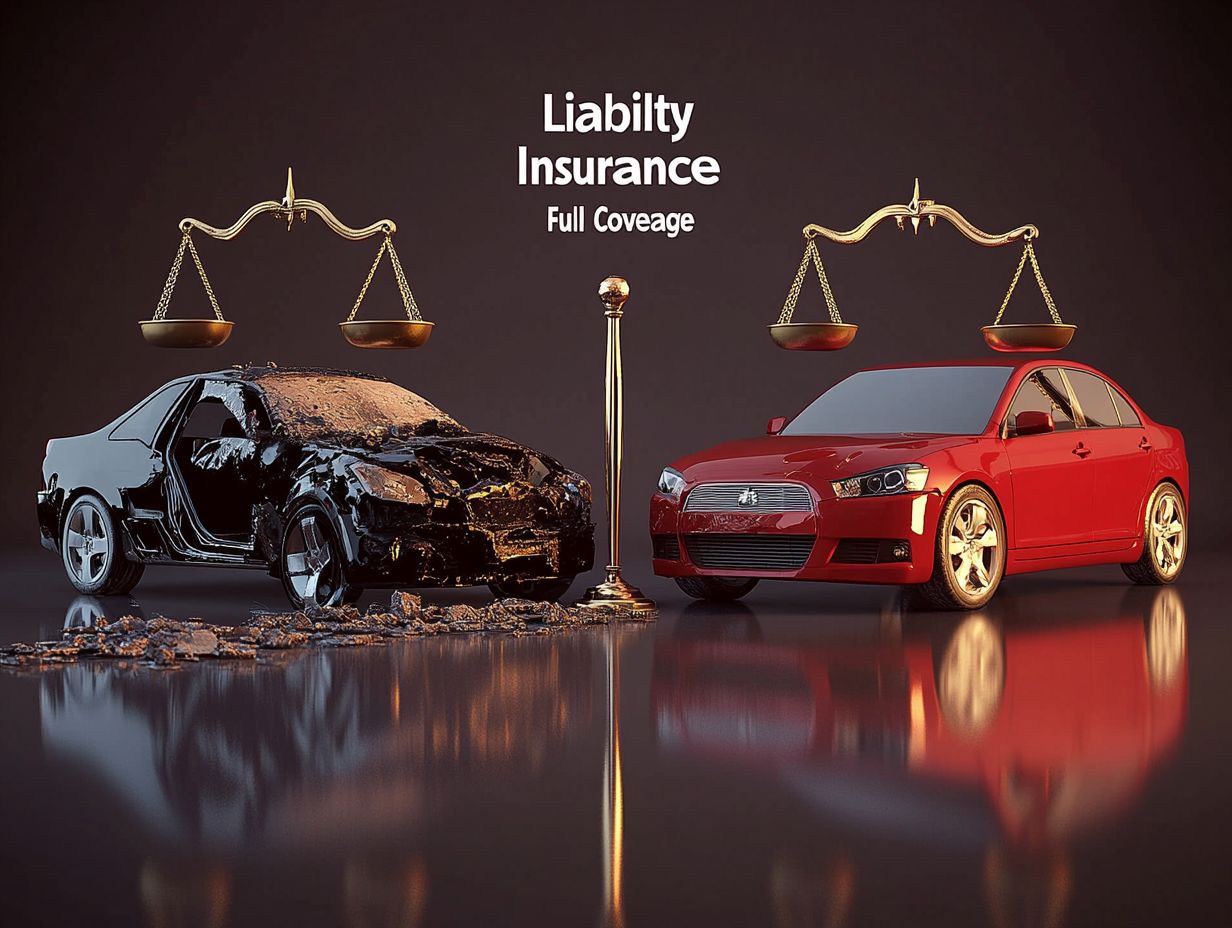Comparing Liability vs. Full Coverage Insurance
Choosing the right car insurance can be quite the challenge, especially with many options available.
This article delves into the essential differences between liability and full coverage insurance. It breaks down what each type includes, shedding light on the pros and cons to empower you in making an informed decision.
You ll discover factors to consider based on your unique needs and budget, along with savvy tips for saving money on your insurance.
By the end of this article, you ll know exactly which insurance option fits your needs!
Contents
Key Takeaways:

- Liability insurance covers damages to others, while full coverage also covers damages to your own vehicle.
- Liability insurance is cheaper but may not provide enough coverage for expensive accidents or vehicle repairs.
- Consider your personal needs and budget when deciding, and explore ways to save money on insurance.
Understanding Liability and Full Coverage Insurance
Understanding liability and full coverage insurance is important for drivers looking to secure money protection from unexpected events on the road. Liability coverage offers fundamental protection for damages you might cause to others, while full coverage expands this safety net to include additional protections, such as collision coverage (which pays for damages to your car after an accident) and comprehensive coverage (which protects against non-accident damage like weather incidents).
Each state has different rules regarding minimum coverage levels and types, making it vital for you to carefully assess your insurance needs, along with the related premiums and commissions.
What Each Type of Insurance Covers
Each type of car insurance offers distinct levels of protection that can significantly influence your financial security on the road. Liability coverage typically steps in to handle damages to other vehicles or injuries caused to others, while full coverage insurance provides a more comprehensive safety net. This includes collision coverage, comprehensive coverage for vehicle damage from non-collision events, uninsured motorist coverage, and Personal Injury Protection (PIP) for medical expenses.
For example, if you find yourself in an accident that damages someone else’s car, liability insurance is there to cover those repairs, shielding you from potential lawsuits. In contrast, full coverage insurance ensures that whether you collide with another vehicle or face damage from a falling tree, your vehicle is protected against a wide array of risks.
Having uninsured motorist coverage is essential; it acts as a safety net in situations where the at-fault driver doesn’t have insurance. Additionally, Personal Injury Protection also provides important medical coverage for injuries sustained in an accident, underscoring the importance of maintaining a robust insurance policy for complete financial protection.
Pros and Cons of Liability Insurance
Liability insurance, commonly known as liability-only insurance, presents a savvy solution for drivers who want to meet state requirements while keeping their premiums and commissions in check.
While it offers essential protection against financial responsibility for damages inflicted on others, it s important to recognize its limitations it doesn t cover your own vehicle damage or personal injuries, turning into a double-edged sword in the event of an accident.
By grasping the average costs linked to liability insurance, you can make well-informed decisions that align with your financial strategy.
Advantages and Disadvantages

The benefits of liability coverage are hard to overlook; it s both affordable and straightforward. This often leads to a lower average annual premium compared to full coverage options.
However, this comes at the expense of limited financial responsibility on your part, as it doesn t cover vehicle damage or medical expenses resulting from injuries sustained in an accident.
Many states require a minimum level of liability coverage, making it a practical choice for those who are budget-conscious. In fact, statistics show that drivers who opt for liability often save thousands over time compared to their fully covered counterparts.
While it may seem appealing at first glance, research reveals that in severe accidents especially those involving significant property damage or multiple injuries liability coverage can leave you financially exposed.
For example, a case study from California highlighted a driver who faced over $150,000 in medical bills but received inadequate compensation due to limited policy coverage. This underscores the critical importance of understanding the trade-offs involved in your insurance choices.
Pros and Cons of Full Coverage Insurance
Full coverage insurance is a powerful tool for protecting your finances! It provides you with comprehensive financial protection, covering both collision incidents which means accidents where your car hits something and non-collision-related vehicle damage, such as theft or vandalism.
This type of insurance protects you from various risks, but it often carries higher insurance costs. It may not be essential for every vehicle owner especially if you re driving an older car.
Assessing your specific needs can help you determine whether this level of coverage is truly worthwhile for you.
Full coverage insurance offers a range of advantages, including strong financial protection and higher coverage limits. However, it also comes with its share of challenges, such as higher insurance costs and the potential for over-insurance in certain situations.
For instance, if you have significant assets, this type of insurance can provide crucial safeguards against financial losses from accidents or damages. This gives you peace of mind in unpredictable scenarios.
The flexibility of full coverage allows you to prepare for various types of damages, whether from collisions or natural disasters, ensuring you re not left exposed.
However, the high premiums associated with these comprehensive plans can strain your budget. You might consider whether such extensive coverage is truly cost-effective.
If you find yourself insuring an older vehicle, you might realize that full coverage could end up costing more than the car’s actual value. It s crucial to review your coverage limits. This way, you can avoid paying too much while ensuring you re still protected.
Factors to Consider When Choosing Between Liability and Full Coverage
When deciding between liability and full coverage insurance, you should weigh several important factors, such as your personal needs, budget constraints, and the state requirements regarding minimum coverage. It’s also crucial to understand the importance of comprehensive liability coverage in your decision-making process.
Grasping your insurance needs is essential for identifying the ideal option for your unique situation. Each choice provides varying levels of protection and financial responsibility.
Making an informed decision now can significantly impact your peace of mind down the road.
Personal Needs and Budget

Evaluating your personal needs and budget is crucial when choosing a car insurance policy. These factors significantly impact your financial responsibility and coverage options.
Taking the time for a thorough assessment can help you uncover the most suitable insurance option. Whether that s liability coverage or full coverage, it will be based on your unique circumstances.
By analyzing your specific vehicle usage like distinguishing between daily commutes and weekend adventures you can gain a clearer understanding of your risk exposure. It’s also important to gauge your risk tolerance.
For some, the peace of mind from comprehensive protection may justify a higher cost. Others might prioritize lower premiums.
Establishing a realistic budget for your insurance premiums involves a detailed look at your financial capabilities. Ensure the necessary coverage types align with your overall financial planning.
This informed approach fosters responsible decision-making and can lead to customized insurance solutions that effectively protect you against unforeseen circumstances.
How to Save Money on Insurance
Saving money on car insurance requires a thoughtful approach. Incorporate strategies like comparing quotes and gaining insight into the factors that influence insurance rates and fees added to your premium.
By taking proactive measures, you can boost your financial protection while effectively reducing the costs tied to your insurance policies.
Tips for Lowering Insurance Costs
Lowering your insurance costs is entirely within your grasp. There are several savvy methods to achieve this.
By maintaining a clean driving record, exploring available discounts, and understanding how fees impact your overall rates, you can take charge of your finances today for a better tomorrow!
One option worth considering is bundling your insurance policies. Combining your auto and home insurance can lead to attractive multi-policy discounts.
Another effective strategy is increasing your deductibles. While this means a higher out-of-pocket expense if a claim arises, it can significantly reduce your premium costs over time.
Don t overlook the potential for savings through safe-driving habits. Many insurers offer discounts for responsible driving, and utilizing technology like apps that monitor your driving behavior can lead to greater financial benefits.
By implementing these strategies, you manage your insurance expenses and adopt a proactive stance toward your overall financial health.
Frequently Asked Questions
What is the difference between liability and full coverage insurance?

Liability insurance only covers damages and injuries caused to others in an accident for which you are responsible. Full coverage insurance also includes coverage for your own vehicle.
Why would I choose liability insurance over full coverage insurance?
Liability insurance is typically cheaper than full coverage, making it more affordable for those on a tight budget. If you have an older or less valuable vehicle, liability insurance may provide adequate coverage.
When should I consider purchasing full coverage insurance?
If you have a newer or more valuable vehicle, full coverage insurance provides added protection and peace of mind in the event of an accident. It may also be required by lenders if you are financing your vehicle.
What factors should I consider when deciding between liability and full coverage insurance?
Aside from cost and the value of your vehicle, consider your driving habits, location, and any potential risks that could increase your chances of being involved in an accident.
Can I switch from liability to full coverage insurance at any time?
Yes, you can usually switch between insurance types at any time. However, switching may result in a change in premium, so it is best to consult with your insurance provider before making any changes.
What if I have both basic and comprehensive insurance?
If you get into an accident, your basic insurance usually covers damages and injuries to the other party.
Meanwhile, comprehensive insurance takes care of damages to your own vehicle.
Don t miss out review your policy to understand the specifics of your coverage!






